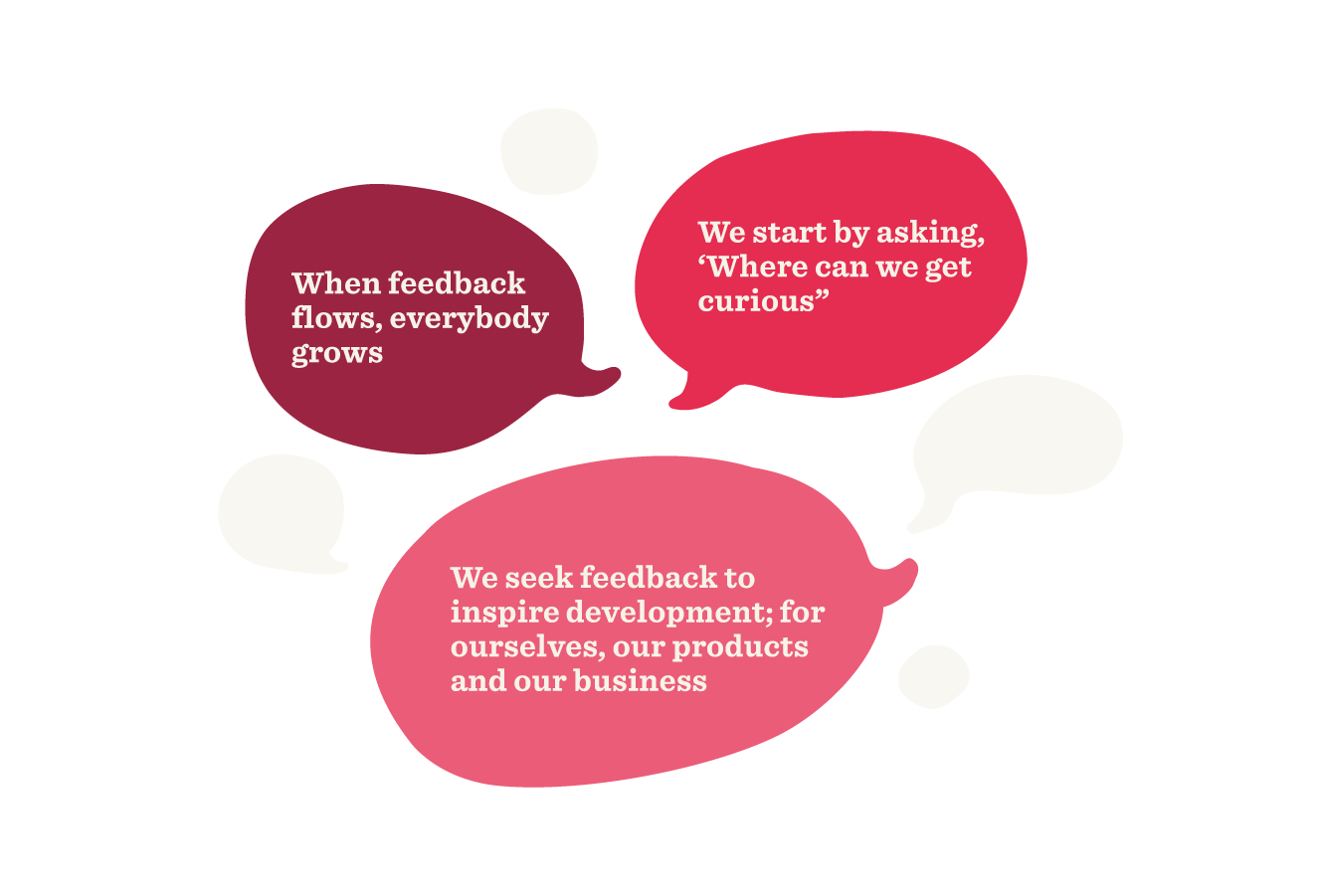Introduction
Unless you’ve been living the exception, “The Great Re-Evaluation” continues to pose some critical challenges to organizations wondering how to stem the tide and ensure they keep their talent close and committed. Many are focused on how to create a clear and compelling cultural narrative, doubling down on themes like how to become more adaptive and innovative.
At the same time, organizations need to ensure they are workplaces where people feel like they belong and can thrive. Professionals today are looking to find places of work that provide personal fulfillment, flexibility, and autonomy over and above the perception of job security and a decent paycheck.
This kind of evolution can’t happen in a vacuum: Organizations need to stay close to how their people feel about their day-to-day experience and how they can effectively meet their people’s needs.

Feedback and the modern workplace
Research shows that “[f]eedback isn’t just a ritual of the modern workplace. It’s the means by which organisms, across a variety of life-forms and time periods, have adapted to survive.”
A missing piece of the modern-workplace puzzle is shifting from the often dreaded bi-annual performance review to a culture of everyday feedback. Business and HR leaders are trying to lighten the load largely associated with traditional approaches to performance feedback.
Instead, they’re pushing for more progressive practices that can simultaneously drive key business outcomes and both personal and professional development. Imagine if conversations about performance simply gave people a moment to pause and reflect on the feedback they’ve received over time.
The case for continuous feedback
To make the case yet stronger, according to research by PWC in partnership with Gallup, 60 percent of employees said they wanted daily or weekly feedback. This increased to 70 percent for those under 30. Overall, 65 percent of employees want more feedback than they are currently getting.
Simply put, today’s professionals want more consistent feedback and will act on it if it’s meaningful to them. We also know that there is 15 percent lower turnover in companies that practice regular feedback.
Business leaders often innocently assume that people will figure out how to give feedback on their own. The reality couldn’t be further from the truth.
“It’s taken me about 15 years to get over the way my first boss used to give me feedback,” a tenured HR leader candidly stated in an interview. Our feedback footprint, or prior feedback experience, is often so ineffective that most people (even those who’ve been around the block) get caught up in their own discomfort. They don’t know where to start, so they stall or stay silent.
Let’s take a moment to understand what happens in your brain when someone decides to “‘drop feedback”’ on you.
The amygdala hijack: Feedback’s effect on the brain
The amygdala is the part of your brain responsible for processing your emotional responses. In a workplace context, a threat can be anything from someone raising their voice and being caught off-guard to hearing something that sounds like personal criticism.

When the brain perceives a threat, the amygdala gets “hijacked” and puts up natural defenses. These defenses cause the frontal lobe, the part of the brain responsible for rationality, to stop functioning. And when we can’t be rational, we shut down. Simply put, if we feel threatened, our brain prevents us from hearing–and the feedback people give either isn’t heard or does more harm than good.
As HR professionals, our collective goal must be to create the conditions for us to hear constructive forms of feedback and empower people to both seek and voice their perspectives.
From giving feedback to asking for it
Neurological research shows “that by switching from giving feedback to asking for it, organizations can tilt their culture towards continuous improvement.”
The key to effective feedback is delivering the message with candor and care. But taking a direct approach can be uncomfortable. For example, many people might secretly hope their parents, partner, or friend will get them that special something they’ve had their eye on for their birthday or another special occasion.
The aim here is to stop sitting around waiting and hoping and instead encourage people to clearly and kindly ask for what they want. You can apply this approach to create healthy and open feedback cultures in the workplace.
Here are some steps to help you along the way.
1) Create alignment up top
Creating momentum and a consistent feedback culture can be challenging, depending on your starting point. The key is to get your leadership team on board.
- Partner with company leaders to establish why seeking more feedback matters to your organization right now. Consider how to gauge the effectiveness of your feedback initiatives and their impact on your company culture. For example, measure engagement, performance, leadership effectiveness, retention, and productivity.
- Facilitate or host a session where you establish your commitment to feedback and the philosophy behind it. Examples companies have landed on include:
- When feedback flows, everybody grows
- We seek feedback to inspire development; for ourselves, our products and our business
- We start by asking, ‘Where can we get curious?’
- Commitment to seeking and receiving feedback starts at the top and trickles down to every team member across the organization. It’s important for each member of your leadership team to recognize that building and maintaining a culture of consistent and constructive feedback starts with them. When leaders set the example and actively seek feedback, listen, and take action, people follow suit.

2) Share the big idea
Visibility and practice are essential to successfully promoting a feedback shift at an organizational level. It’s critical to think about fun and engaging ways to build a rallying cry:
- Share the message from the top down. Company leaders, starting with the CEO, must openly talk about their personal commitment to an open feedback culture and why they’ve made this commitment. As they share the message with each team, leaders should have creative freedom regarding how they want to bring their promise to life.
- Keep feedback a part of your everyday culture. Some companies display a reminder on in-house screens, communication channels, or intranet sites to keep their feedback philosophy front-of-mind.
- Lastly, think about opportunities in existing forums to reinforce both the message and practice of seeking feedback first. Examples include training programs, team meetings, and one-on-ones.

3) Offer people a simple, sticky framework
There are many feedback frameworks out there (SBI, Radical Candor, and The Accountability Dial, to name a few), and many of them overlap. However, most of them focus on giving feedback as opposed to asking for it first.
Here’s an example of a more progressive framework for modern companies shifting to an open and consistent feedback culture.
Set it up
This is about giving the person you are going to ask for feedback a chance to prepare. A little bit of a heads-up goes a long way and will increase the chances of getting a thoughtful response. It’s also a good idea to mention why this feedback is important to you.
Seek the specific
Now that you’re meeting for feedback, it’s time to ask specific and open questions. The more specific your questions, the richer and more valuable the responses will be.
Asking genuine, curious questions like the following can help create a safe space for people to feel comfortable answering honestly and lower the chances of an amygdala hijack:
“I’ve been reflecting on my presentation style. I’d love to ask what you found effective and what you thought could be better?” instead of more general questions like “Hey, have you got any feedback for me?”
Summarize
When it comes to feedback, you don’t need to agree, but it’s critical to listen and respect what your people say and think. Sharing personal opinions, especially with managers, can be stressful. This is why it’s crucial to start off by saying, “thank you.”
It’s important here to be sensitive, check with people to make sure you understand each of their points, and then dig deeper for clarification where necessary. Lastly, be sure to mention what you plan to do–or not do–as a result of what you heard. You can invite further feedback once you’ve adapted your approach or seek more input from others before making a call about how to take action.

4) Celebrate impact
Make it your mission to look out for stories of what’s changed as a result of seeking feedback first. What new ideas did the feedback spark? What dynamics changed within a team? What became possible that you didn’t expect?
HiBob hosts leadership development programs to train company leaders on best practices and feedback techniques. One HiBob leader who went through the program really connected to the idea that forging a feedback culture started with him as a manager.
Will is a technical sales team lead. He decided to redesign his approach to a standing team meeting where, historically, he told the team to come ready to discuss a particular customer call recording. Participation was often mixed because some team members arrived unprepared.
To encourage active participation from every team member, Will decided to change the expectation. Instead of leading the meeting himself, he asked everyone to come ready to share two to three things they thought stood out about the call and specific techniques they would be willing to try themselves. He also asked everyone to bring one to two constructive ideas of what could have been more effective.
First, Will put himself up for scrutiny. This set the example for the team and showed them that he was open to learning opportunities, too. In less than two months, the team culture transformed into one centered around proactive and continuous feedback. In fact, the team’s practical feedback culture now extends beyond the established meeting format and is part and parcel of everything they do. The result? The quality and consistency of the team’s technical prospect calls greatly improved, and they’re closing more lucrative deals.

5) The icing on the cake
Consider creating a tracking template to support a more formal performance review process. This is where folks can capture and share the feedback they’ve gathered during their one-on-one meetings with their managers.
It’s also a great place to document which pieces of feedback they acted on, and where they can still improve. Just think of the time you could save, and the quality of the conversations your people leaders could have as a result.
Own your own development
In this guide, we’ve mapped out the dream scenario where you are ready to roll up your sleeves and influence an organizational shift towards leaning into feedback.
But to keep things really simple, everyone–from the C-suite and HR leaders to managers and employees–can start doing this for themselves now, starting here:
Identify areas for self-improvement
Think of an area (or areas) where you can improve. What are you hoping to master, and why is it important to you to upskill here?
Recommended For Further Reading
Actively seek out feedback from peers or managers
Think of three people who’ve seen you in action in the last week. Who can you trust to give you constructive criticism? Once you’ve identified these people:
- Set up a time to talk to them so they can come prepared.
- Seek specific feedback with an open question. Listen and dig in deeper if something is unclear.
- Say thank you and summarize. Share what you are going to do, if anything, with what you heard. If it feels appropriate, it can also be a good idea to brainstorm about your plans of action together with your trusted peers.
Cultivating cultures of continuous feedback can make a huge impact on your own and your teams’ professional development and growth. It’s also fundamental to business resilience and success. Now is the time to stop waiting and start clearly asking for the feedback you want. Take the steps you need to get what’s on your gift list throughout the year. It’s the best gift you can give yourself and your teams.
This guide was written by Louise Gilliland, founder of Courageous Conversations. She’s an experienced executive, team and leadership coach, and consultant who recently returned to the UK after six years in the Bay Area. Lou is an outdoors and exercise enthusiast. When she’s not running along the canal or trying to improve her tennis serve, she’s experimenting in the kitchen with her son or conjuring up design ideas for their new home.
Meet Bob
An HR platform such as Bob offers a one-stop-shop for all things people. It sits at the center of your HR ecosystem, is fully customizable, and grows with your organization.
For HR, it delivers automation of many common processes, allows greater oversight and visibility of the business, and centralizes all people data in a secure, user-friendly environment.
For managers, it provides access to data and insights to help them lead more effectively and streamline processes.
For employees, it’s the tools and information they need to connect, develop, and grow throughout their journey.
In a short time, Bob can be deployed to enable communication, collaboration, and connectivity that drives stronger engagement, productivity, and business outcomes.
